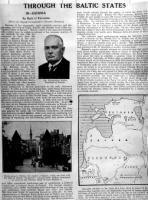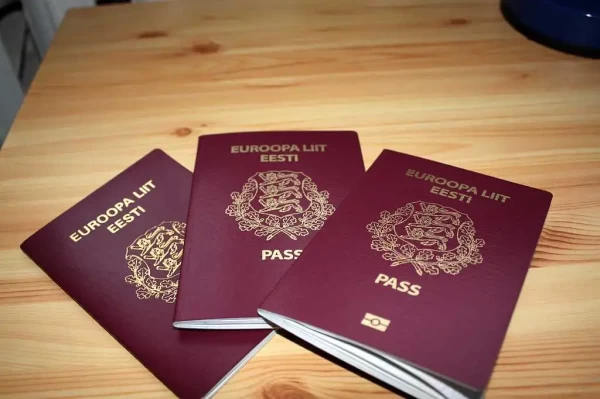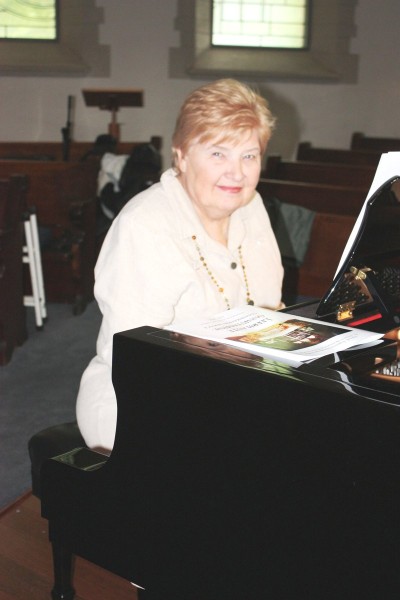THROUGH THE BALTIC STATES
III –ESTONIA
An Oasis of Toleration
(From our Special Correspondent – Tallinn, Estonia)
Because of remarcably rapid economic recovery and the prevailing low cost of living, Estonia has recently been called the “Golden Corner of Europe.” But whatever fair name this beautiful little country may be called on account of her economic position, it can certainly be said that her treatment of Jews does her honour. Estonia is the only country in Eastern Europe where neither the Government nor the people practise any discrimination against Jews and where Jews are left in peace. In sharp contrast to the other Baltic States, the cultural autonomy granted to Estonian Jews ten years ago still holds good, and Jews are allowed to lead a free and unmolested life and fashion it in accord with their national and cultural principles.
The Estonian Jewish Community is a small one. Out of a total population of 1 000 000, only 6 000 or about .5 %, are Jews. Over 2000 of them live in Tallinn, the capital, the others living in Tartu (Dorpat), Narva, Valga, Pärnu and other smaller townships and villages. The first Jewish settlements in Estonia date back in the early thirteenth century. In 1742, however, the Russian Tsar, under whose domination Estonia was for centuries, expelled all Jews. In 1828, some 500 Jewish boys aged from ten to fourteen were, according to a local historian, sent to Estonia to serve in Tsar Nicolas’ army. The majority of them, unable to bear ensuing hardships, died, while the survivors were later allowed to remain and settle in Estonia. In 1856, there was in Tallinn, then known as Reval, a Jewish Community numbering fifty. Its growth was slow, as the Russians hindered Jewish settlement in Estonia and particularly in Reval, which was one of Russia’s main fortresses.
When Estonia won her independence after the War, the Jews were granted full rights. By the Estonian Constitution, all national minorities were granted equality, while every minority numbering over 3000 was, if it so desired, also granted cultural autonomy, with the privilege of organising and administering public and private schools and other educational institutions and of establishing a Cultural Council and a Cultural Board of Control. The German minority, numbering some 18 000, immediately took advantage of this privilege and established their Cultural Board and their own schools. The Jews were longer in organising themselves culturally. In 1926, representatives of Estonian Jewry finally met in Tallinn and formed a Cultural Council and Board (the latter is now presided over by Mr. Ajzenstein, a leading Jewish figure in Estonia). The Board organised three Jewish schools, towards the upkeep of which the State contributes the major part. Besides the State language, Hebrew and Yiddish are now taught to some 500 Jewish children in Tallinn, Tartu and Valga. The Board consists of twenty-seven members elected every three years. Its activities are controlled by the Estonian Ministry of Education. It can levy taxes, which the Govrnment collects for it, and every Jew is considered a member of the Jewish national minority and subject to the Board’s rules. On the other hand, every Jew has the right to leave the Jewish Community, if he so desires. This, however, occurs very rarely, since Estonian Jews are proud of their cultural autonomy.
The collective spirit predominating among the Estonian Jews is best evidenced by the “Bialik Club” in Tallinn, one of the finest cultural institutions in Eastern Europe, containig a well-equipped library, a spacious reading room and a theatre. The 300 000 Jews of Warsaw have nothing to equal it. Its moving spirit, chief organiser and protector is Mr. N. Golsztein, a wealthy business man.
Estonia’s correct attitude towards its minorities has also given local Jewry another opportunity which is unique in Europe to-day. As a logical conclusion to their cultural autonomy, the Jews have been given the right to establish a separate Chair of Judaica at Estonia’s only University at Tartu, after a petition by the Jewish Cultural Board to the Government in 1929. The Government promptly announced that such a Chair would be opened as part of the Faculty of Philosophy, with the right of the students to graduate in that department, the funds to be provided by the Jewish Cultural Board, but the accommodation to be granted by the University. Owing to the lack of funds, the Chair was not opened till 1934, the public spirit of Mr. Paul Goodman, of London, who is specially interested in Tartu, making its inception possible. Dr. Lazar Gulkiewicz, a former lecturer in Leipzig, was invited to occupy the Chair. To-day, about 12 per cent of the all-Jewish students at the Tartu University attend this Faculty. Apart from its great value for Jewish studies, the Chair also plays a beneficial part in spreading Jewish thought and knowledge both inside and outside the University. Non-Jewish professors are invited to attend the lectures, which are also frequented by a number of non-Jewish students.
Estonia’s attitude to her Jews at a time when in many of the neighbouring countries they are shamelessly deprived of human rights has been of benefit not only to the Jews but also to the country at large. Estonia depends on export trade, in the rapid development of which the Jews have played a most beneficial role. If Estonia has overcome the crisis and is without unemployment, the Jews are largely responsible, and this is readily conceded by the Estonians themselves. It is significant that in the other Baltic countries where discrimination against Jews is general, economic recovery is much slower than in Estonia. A prominent Estonian leader with whom I discussed the connection which undoubtedly exists, particularly in the Baltic countries, between the treatment of Jews and the economic situation, said: “We have granted complete freedom to the Jews, just as we have to the other minorities. The Jews have repaid a thousandfold by their industry, loyalty and patriotism.”
Of course, Nazi propaganda penetrates to Estonia as elsewhere. Not long ago, Estonian Nationalists, known as the “Vasps,” tried to spread anti-Jewish feelings. However, thanks to Konstantin Paets, the President, the anti-Jewish movement was nipped in the bud before it could affect the mutual relations between Jews and non-Jews.
Jewish Chronicle 25 – 9 – 1936 LONDON (3)
Archived Articles | 01 Apr 2007 | EWR
Viimased kommentaarid
Kommentaarid on kirjutatud EWR lugejate poolt. Nende sisu ei pruugi ühtida EWR toimetuse seisukohtadega.
ja just praegu kuulsin vikerraadiost et Eesti kaotas iisrealile jalgapallis(soccer)0:4 ja Azerbaidzaan oli võitnud Soome.
Damn soome ugrilastel ikka jalgpall ei istu.
Damn soome ugrilastel ikka jalgpall ei istu.
miks ikka nii ähvardavalt,ei ole mõtet,kulla mees,elus on palju tähtsamat kui see pronkssõdur,see sõdur mulle merenutab,näiteks minu isa tapjat,kui hirmus,eks,kuid teiseks minu mees oli ka see sõdur,mis siis saab,teda sunniti,kokkuvõtes ikka parem kui ära viia,see oleks keskmine kõigile,mina ei nuta isa pärast,mul oli väga hea isa,ei anna andeks kunagi,kuid pean aru saama,et sõdur oli sunnitud,kuid neid võimumehi neid tuleb ikka karistada,nad on verised,ja lõpuks,et vargad ei mõnitaks rahvast,nii eestlasi kui ka venelasi,osa venelased on teist moodi,siis parem ikka ära viia,siis ei näe neid joodikuid ka sõduri juures,sest see teeb haiget ja viha
Liim pidevalt taunib Idel Jakobsoni ja mitme teisi nimesid kui vaenulikud reeturid. Tuleb aga hoopis välja et just Liim on bolsheviku käepikendus, sest kui ta lõpuks niikaugele jõuab et õhku laseb Pronkssõdur, ju siis olen mina ja pool miljon eestlast mu seljataga et venelased koos tankidega marsivad peatselt üle piiri. Nii et antud juhul on Liim, Böhm ja j Rebane juudivastase kallakuga idealistid kes soovivad vaenu õhutada meie Kuldses Euroopa nurgas. Pähhhh neile....
Archived Articles
TRENDING





















